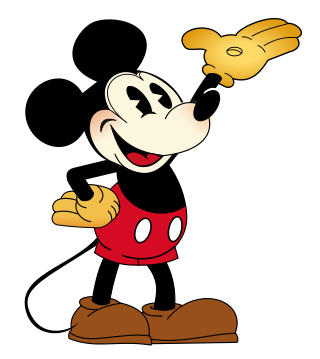
Mickey Mouse is an American cartoon character co-created in 1928 by Walt Disney and Ub Iwerks. The longtime icon and mascot of the Walt Disney Company, Mickey is an anthropomorphic mouse who typically wears red shorts, large shoes, and white gloves. He is often depicted alongside his girlfriend Minnie Mouse, his pet dog Pluto, his friends Donald Duck and Goofy and his nemesis Pete among others.

Mickey Mouse Works is an American animated television series produced by Walt Disney Television Animation featuring Mickey Mouse and his friends in a series of animated shorts. The first Disney television animated series to be produced in widescreen high definition, it is formatted as a variety show, with skits starring Mickey Mouse, Minnie Mouse, Donald Duck, Daisy Duck, Goofy, Pluto and Ludwig Von Drake while Horace Horsecollar, Clarabelle Cow, Morty and Ferdie Fieldmouse, Huey, Dewey and Louie, Chip 'n' Dale, Scrooge McDuck, Pete, Humphrey the Bear, J. Audubon Woodlore, Dinah the Dachshund, Butch the Bulldog, Mortimer Mouse, José Carioca, and Clara Cluck appear as supporting or minor characters. Musical themes for each character were composed by Stephen James Taylor with a live 12-piece band and extensive use of the fretless guitar to which the music of the series was nominated for an Annie Award in both 1999 and 2001. Most of the shorts from the series were later used in House of Mouse.

Minnie Mouse is an American cartoon character created by the Walt Disney Company. As the longtime sweetheart of Mickey Mouse, she is an anthropomorphic mouse with white gloves, a red or pink bow, blue polka-dotted dress, white bloomers and yellow low-heeled shoes occasionally with ribbons on them. The Mickey Mouse comic strip story "The Gleam" by Merrill De Maris and Floyd Gottfredson first gave her full name as Minerva Mouse, although this is seldom used.

Clarabelle Cow is a cartoon character created by The Walt Disney Company. As an anthropomorphic cow, Clarabelle is one of Minnie Mouse's best friends. She was once depicted as the girlfriend of Horace Horsecollar, although now she is often paired with Goofy.

The Mickey Mouse universe is a fictional shared universe which is the setting for stories involving Disney cartoon characters, including Mickey and Minnie Mouse, Donald and Daisy Duck, Pluto and Goofy as the primary members, and many other characters related to them, being most of them anthropomorphic animals. The universe originated from the Mickey Mouse animated short films produced by Disney starting in 1928, although its first consistent version was created by Floyd Gottfredson in the Mickey Mouse newspaper comic strip. Real-world versions also exist in Disneyland and Tokyo Disneyland, called Mickey's Toontown.

Horace Horsecollar is a cartoon character created in 1929 at Walt Disney Animation Studios. Horace is a tall anthropomorphic black horse and is one of Mickey Mouse's best friends. Characterized as a boastful show-off, Horace served as Mickey’s sidekick in Disney's early black-and-white shorts.
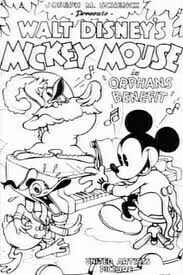
Orphan's Benefit is an American animated short film produced by Walt Disney Productions in black-and-white. It was first released in 1934 and was later remade in Technicolor in 1941 under the corrected title Orphans' Benefit. The cartoon features Mickey Mouse and his friends putting on a vaudeville-style benefit show for a group of unruly orphans. It contains a number of firsts for Disney, including the first time in which Mickey Mouse and Donald Duck appear together, and was the 68th Mickey Mouse short film to be released, and the sixth of that year. It was also the cartoon which had the first story to be written that featured Donald Duck, though it was the second Donald Duck short to be produced and released, after The Wise Little Hen.

Mickey's Revue is a 1932 Walt Disney cartoon, directed by Wilfred Jackson, which features Mickey Mouse, Minnie Mouse, Horace Horsecollar and Clarabelle Cow performing a song and dance show. The film was delivered to Columbia Pictures on May 12 and released on May 27, 1932. It was the 41st Mickey Mouse film, and the fifth of that year.
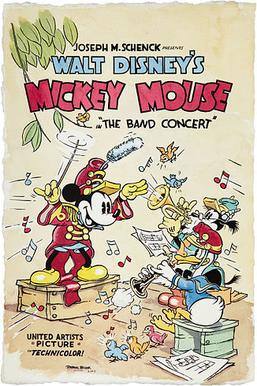
The Band Concert is a 1935 American animated short film produced in 3-strip Technicolor by Walt Disney Productions and released by United Artists. The 73rd short film in the Mickey Mouse series, it was the second release of the year, and notable as the first in the series to be produced in color.

Mickey Mouse Adventures is a Disney comic book first published by Disney Comics from 1990 to 1991. It featured Mickey Mouse as the main character along with other characters from the Mickey Mouse universe. Somewhat similar in style to the animated series DuckTales, it was based on the continuity of earlier print material starring Mickey, mainly Floyd Gottfredson's stories in the Mickey Mouse comic strip.
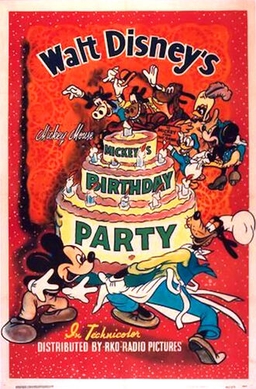
Mickey's Birthday Party is an American animated short film directed by Riley Thomson, produced by Walt Disney Productions and distributed by RKO Radio Pictures. The 114th short to feature Mickey Mouse, it was released on February 7, 1942. The animated film was directed by Riley Thomson and animated by Les Clark, James Moore, Ken Muse, Armin Shaffair, Riley Thompson, Bernie Wolf, and Marvin Woodward. It was the 116th short in the Mickey Mouse film series to be released, and the first for that year.
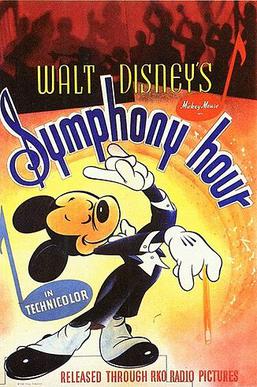
Symphony Hour is a 1942 American animated short film produced by Walt Disney Productions and released by RKO Radio Pictures. The cartoon depicts Mickey Mouse conducting a symphony orchestra sponsored by Pete. The film was directed by Riley Thomson and features music adapted from the "Light Cavalry Overture" by Franz von Suppé. The voice cast includes Walt Disney as Mickey, Billy Bletcher as Pete, and John McLeish as a radio announcer. It was the 117th short in the Mickey Mouse film series to be released, and the second for that year.

The Whoopee Party is a Mickey Mouse short animated film first released on September 17, 1932. It was the 46th Mickey Mouse short, and the tenth of that year.

The Plowboy is a Mickey Mouse short animated film first released on June 28, 1929, as part of the Mickey Mouse film series. It was the eighth Mickey Mouse short to be produced, the fifth of that year.
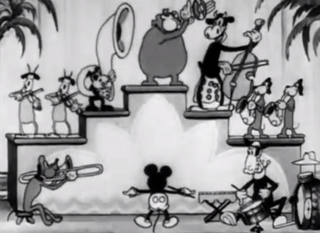
Blue Rhythm is a 1931 Mickey Mouse animated short film directed by Burt Gillett, produced by Walt Disney Productions and distributed by Columbia Pictures. It was the 31st short in the Mickey Mouse film series, and the seventh of that year. The plot focuses on a multifaceted performance of W. C. Handy's "St. Louis Blues". The film features the voices of Walt Disney as Mickey and Marcellite Garner as Minnie Mouse.

Ye Olden Days is a 1933 animated short film, released as part of the Mickey Mouse film series. It was directed by Burt Gillett and produced by Walt Disney. It was the 55th Mickey Mouse short film, and the fifth of that year.
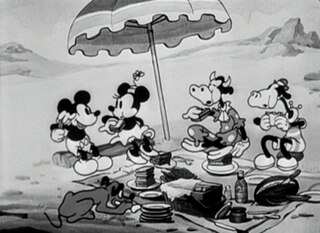
The Beach Party is a 1931 Mickey Mouse animated short film directed by Burt Gillett, produced by Walt Disney Productions and distributed by Columbia Pictures. It was the thirty-fourth short in the Mickey Mouse film series, and the tenth produced that year.
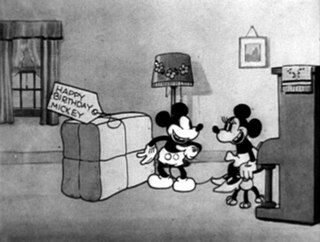
The Birthday Party is a Mickey Mouse short animated film first released on January 2, 1931, as part of the Mickey Mouse film series. It was the twenty-fifth Mickey Mouse short to be produced, the first of that year.
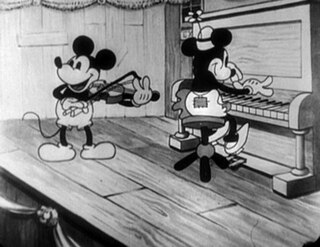
The Shindig is a Mickey Mouse short animated film first released on July 11, 1930, as part of the Mickey Mouse film series. It was the twentieth Mickey Mouse short to be produced, the fifth of that year.
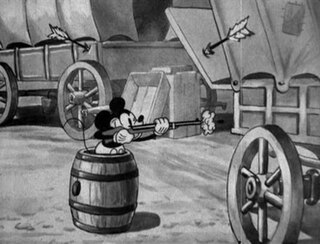
Pioneer Days is a Mickey Mouse short animated film first released on November 20, 1930, as part of the Mickey Mouse film series. It was the twenty-fourth Mickey Mouse short to be produced, the ninth of that year.





















